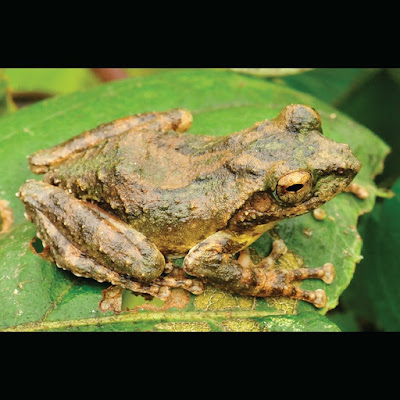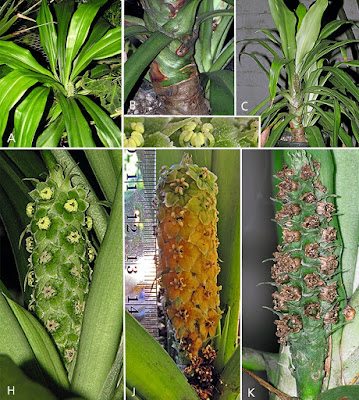[Most Recent Entries] [Calendar View]
Thursday, July 5th, 2018
| Time | Event | ||||||
| 2:57a | [Herpetology • 2018] Kurixalus yangi • A New Species of Kurixalus (Anura, Rhacophoridae) from western Yunnan, China
Abstract A new species of the genus Kurixalus (Anura: Rhacophoridae) is described from western Yunnan, China. Genetically the new species, Kurixalus yangi sp. n., is closer to Kurixalus naso than to other known congeners. Morphologically the new species is distinguished from all other known congeners by a combination of the following characters: smaller ratios of head, snout, limbs, IND, and UEW to body size; male body size larger than 30 mm; curved canthus rostralis; weak nuptial pad; brown dorsal color; absence of large dark spots on surface of upper-middle abdomen; presence of vomerine teeth; gold brown iris; single internal vocal sac; serrated dermal fringes along outer edge of limbs; granular throat and chest; rudimentary web between fingers; and presence of supernumerary tubercles and outer metacarpal tubercle. Keywords: China, Kurixalus yangi sp. n., new species, Western Yunnan
Kurixalus yangi sp. n. Etymology: The species name is dedicated to Professor Datong Yang from Kunming Institute of Zoology, Chinese Academy of Sciences for his outstanding contribution to herptofauna research of Yunnan, China. Diagnosis: The new tree frog species is assigned to the genus Kurixalus based on a combination of the following characters: tips of digits enlarged to discs, bearing circum-marginal grooves; small body size (SVL range of 31.6–34.7 mm in adult males; Table 1); finger webbing poorly developed and toe webbing moderately developed; serrated dermal fringes along outer edge of forearm and tarsus; an inverted triangular-shaped dark brown mark between eyes; dorsal brown “) (” saddle-shaped marking; and coarse dorsal and lateral surfaces with small, irregular tubercles (Nguyen et al. 2014a, Nguyen et al. 2014b, Yu et al. 2017b). Our previous molecular study placed the new species in Kurixalus with other known congeners (Yu et al. 2017a). Kurixalus yangi sp. n. can be distinguished from its congeners by a combination of the following characters: male body size larger than 30 mm; smaller ratio of head length to body size; curved canthus rostralis; weak nuptial pads; brown dorsal color; absence of large dark spots on upper-middle abdomen; presence of vomerine teeth; gold brown iris; single internal vocal sac; serrated dermal fringes along outer edge of limbs; granular throat and chest; interorbital space longer than upper eyelid; rudimentary web between fingers; and presence of supernumerary tubercles and thenar tubercle.
Distribution and natural history: The new species is known from border region with northern Myanmar in western Yunnan, China (Fig. 2) and northern Myanmar according to Yu et al. (2017a). At the type locality, the new species was found calling on leaves of bushes adjacent to a road at night (Fig. 8). Specimens from the other two sites were found calling on broad leaves at the edge of an evergreen forest. Tadpoles, eggs and females were not found. Guohua Yu, Hong Hui, Dingqi Rao and Junxing Yang. 2018. A New Species of Kurixalus from western Yunnan, China (Anura, Rhacophoridae). ZooKeys. 770: 211-226. DOI: 10.3897/zookeys.770.23526 Yu G, Rao D, Matsui M, Yang J (2017a) Coalescent-based delimitation outperforms distance-based methods for delineating less divergent species: the case of Kurixalus odontotarsus species group. Scientific Reports. 7: 16124. DOI: 10.1038/s41598-017-16309-1 Yu G, Wang J, Hou M, Rao D, Yang J (2017b) A new species of the genus Kurixalus from Yunnan, China (Anura, Rhacophoridae). Zookeys. 694: 71–93. DOI: 10.3897/zookeys.694.12785 Yu G, Zhang M, Yang J (2010) A species boundary within the Chinese Kurixalus odontotarsus species group (Anura: Rhacophoridae): New insights from molecular evidence. Molecular Phylogenetics and Evolution. 56: 942–950. DOI: 10.1016/j.ympev.2010.05.008 Yu G, Zhang M, Yang J (2013) Molecular evidence for taxonomy of Rhacophorus appendiculatus and Kurixalus species from northern Vietnam, with comments on systematics of Kurixalus and Gracixalus (Anura: Rhacophoridae). Biochemical Systematics and Ecology. 47: 31–37. DOI: 10.1016/j.bse.2012.09.023 | ||||||
| 10:58a | [Botany • 2018] Rohdea harderi (Asparagaceae) • A New Species from northern Vietnam
Summary Rohdea harderi N. Tanaka, D. P. Hannon & Aver., a new species from northern Vietnam, is described and illustrated. It is most closely allied to R. verruculosa from SW China, but differs mainly by the narrower annular appendage at the throat of the perianth tube, explanate, subacute, crenulate, externally smooth perianth segments, smaller stigma and obovoid ovary. Its affinity is briefly discussed on the basis of floral traits. A key to the species known from Vietnam is also provided. Key Words: Convallarieae, Indochina, phenotypic traits, Tupistra Rohdea harderi N. Tanaka, D. P. Hannon & Aver. sp. nov. Type: Vietnam, Son La province, D. K. Harder et al. 7276, dried herbarium specimen prepared by D. P. Hannon s.n. on 21 April 2017 from a plant cultivated at Huntington Botanical Garden (HBG 90679) (holotype, HNT 13048!). Recognition: Most closely allied to Rohdea verruculosa (Q. H. Chen) N. Tanaka (Tanaka 2003: 332, excluding Tupistra annulata H. Li & J. L. Huang and its homotypic synonym), but differs from it chiefly by the narrower annulus (0.5 vs 1 – 1.5 mm wide) at the throat of the perianth tube, explanate, crenulate, subacute, smooth perianth segments (vs incurved, nearly entire, caudate(-filose), externally verruculose segments), smaller stigma (0.7 – 0.8 vs c. 1.3 mm across), and obovoid ovary (vs ovoid or globose ovary). Distribution: Endemic to NW Vietnam: Dien Bien and Son La provinces. Habitat: In Dien Bien province, Rohdea harderi occurs on shady forest floor or among rocks in humid, highly degraded primary evergreen broadleaved forest on very steep slopes of mountains composed of solid limestone at elevations 1100 – 1300 m a.s.l. (Averyanov et al. as CPC 2115, LE). In Son La province, it occurs as undergrowth on light to heavily shaded forest floor in secondary or primary forest with some timber species (mainly Burretiodendron Rehder and conifers) removed along ridgetop of crystalline limestone around 1468 m in elevation (Harder et al. 7276 as D. P. Hannon s.n., HNT 13048). Etymology: The specific epithet honours Dr Daniel K. Harder as founder of the Missouri Botanical Garden’s Viet Nam Botanical Conservation Program, who discovered, collected and brought the new species into cultivation, thereby greatly contributing to the improvement of our knowledge on the plant. Noriyuki Tanaka, Dylan P. Hannon, Daniel K. Harder, Leonid V. Averyanov and Sean C. Lahmeyer. 2018. Rohdea harderi (Asparagaceae), A New Species from northern Vietnam. Kew Bulletin. 73:31. DOI: 10.1007/s12225-018-9756-3 |
| << Previous Day |
2018/07/05 [Calendar] |
Next Day >> |








